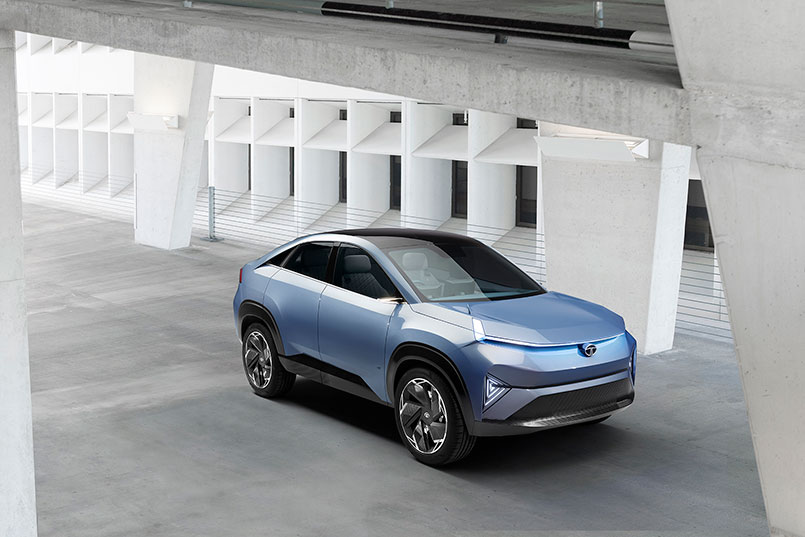
A few years ago, there was a prevailing sentiment that car design had stagnated, with manufacturers focusing solely on aerodynamic and conventional aesthetics. Fortunately, recent trends show a resurgence of bold, experimental designs and diverse body styles.
The Tata Curvv EV offers two battery options: a 45 kWh and a 55 kWh pack. The 45 kWh variant uses cylindrical cells, while the 55 kWh pack features new prismatic cells, providing an 8% boost in energy density. The Curvv EV is powered by a permanent magnet liquid-cooled motor, delivering 148 BHP with the 45 kWh battery and 165 BHP with the 55 kWh battery. Tata claims that with the 55 kWh pack, 75% of customers should achieve a range of 400-425 km, while the 45 kWh pack offers a range of 330-350 km (more details to follow). We had the opportunity to test the top 55 kWh variant in Udaipur for a day. Here’s a closer look.
Tata Curvv EV Price and Competition
The Tata Curvv EV has been introduced at an introductory price of Rs. 17.49 lakh for the Creative variant with the 45 kWh battery. This variant is also available in two additional trims: Accomplished (Rs. 18.49 lakh) and Accomplished +S (Rs. 19.29 lakh). The 55 kWh battery variant comes in three trims: Accomplished (Rs. 19.25 lakh), Accomplished +S (Rs. 19.99 lakh), and the top-of-the-line Empowered + (Rs. 21.25 lakh).
Read: Tata Safari 2024 Owner’s Feedback
In terms of competition, the Curvv EV primarily rivals the MG ZS EV and the Mahindra XUV 400. When compared to these models, Tata’s pricing appears competitive, especially considering the Curvv EV’s superior powertrain compared to the XUV 400 and the ZS EV’s somewhat dated feel. Compared to the smaller Nexon EV, the Curvv EV is priced about Rs. 2-3 lakhs higher, depending on the variant. While there might be some overlap between the two SUVs, Tata anticipates that each model will appeal to different customer segments.
Read: How To Switch Car Insurance Compnies
Tata Curvv EV Running Costs
The Tata Curvv EV offers two battery pack options: 45 kWh and 55 kWh. To fully charge each battery, you’ll need approximately 45 and 55 units of electricity, respectively. The cost per unit of electricity varies depending on your location and the applicable slab, but it averages around Rs. 8 per unit. Therefore, a full charge will cost you approximately Rs. 360 for the 45 kWh battery and Rs. 440 for the 55 kWh battery.
The claimed range for the 45 kWh and 55 kWh options is 502 km and 585 km, respectively. For real-world conditions, Tata provides a C75 range estimate, which reflects what 75% of users are expected to achieve. The C75 range for the 45 kWh battery is 330-350 km, while for the 55 kWh battery, it’s 400-425 km. These figures are quite respectable, and when calculating running costs, you’ll be spending roughly Rs. 1 per km.
Tata Curvv EV: Pros and Cons
Pros:
- Distinctive Design: The coupe-SUV styling stands out and draws attention on the road.
- Competitive Pricing: Offers good value compared to rivals such as the ZS EV, XUV400, and Nexon EV Long Range.
- Powerful Performance: The 165 BHP motor delivers an enjoyable driving experience, and the 400 km real-world range is ample for both city and highway travel.
- Stable Handling: Offers well-sorted road manners and high-speed stability.
- City-Friendly: Zero emissions, low “fuel” costs, no gears, and light controls make it ideal for urban driving.
- Spacious Boot: The 500-litre boot provides plenty of room for family trips and luggage.
- Feature-Rich: Includes flush door handles, powered tailgate with gesture control, a 9-speaker JBL audio system, panoramic sunroof, V2L and V2V charging, Arcade.ev app suite, rear seat recline adjustment, and more.
- Advanced Safety: Comes with a comprehensive suite of safety features including level 2 ADAS, 6 airbags, all-wheel disc brakes, pedestrian acoustic alert system, ESP, front parking sensors, 360-degree camera, TPMS, hill hold assist, and hill descent control.
Cons:
- Rear Seat Discomfort: The rear seats may be uncomfortable for tall passengers due to high floor, limited headroom (a result of the coupe styling), and challenging ingress and egress.
- Firm Ride: The 18-inch wheels (on the top variant) contribute to a firmer suspension, which can make rough roads feel more noticeable. The 17-inch wheels on lower variants might offer a better ride.
- Build Quality: While acceptable, the build quality and fit & finish could be improved.
- Limited Rear Visibility: As with many coupe-SUVs, rearward visibility is compromised.
- Missing Features: Lacks telescopic steering wheel adjustment, front passenger cupholders, and a rear sunshade.
- EV Challenges: Faces typical electric vehicle issues such as charging infrastructure and range anxiety.
- After-Sales Service: Tata’s after-sales service quality can be inconsistent, making it somewhat unpredictable.
- New Model Risks: Being a new Tata launch, there may be initial quality issues or niggles, particularly in the early batches.
Related posts:
- The Grand Launch of Toyota Vellfire in India
- The 2023 Porsche 911 Carrera T: A Sports Car Worth Preserving
- Citroen Type Holidays Concept
- Embracing the Essence of Bobber Motorcycles: Top 10 Picks for 2024
- Volvo EX90: A Scandinavian Electrification Odyssey
- Kia Becomes the Fastest Carmaker to Achieve 1 Million Domestic Sales















